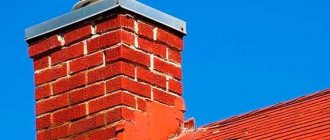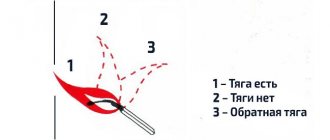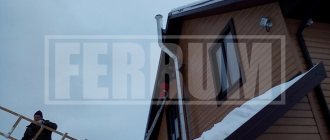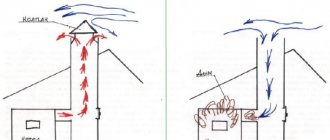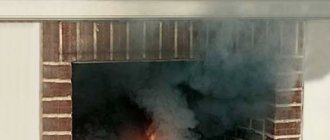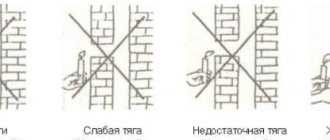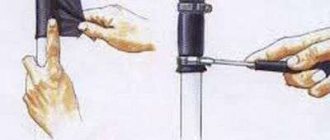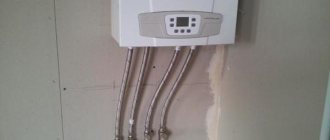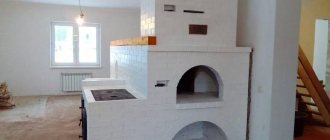Stove heating, along with such obvious advantages as reliability and efficiency, exhibits no less significant disadvantages - smoke into the room. Let's look at why a stove smokes in a home, bathhouse or other room, what are the main reasons for the disturbance in the normal draft of the stove during its constant operation, as well as what to do and what actions need to be taken to restore its functionality in each case.
The main reason for a stove smoking indoors is improper kindling after a long period of inactivity. Source gazeta-licey.ru
Where to start checking your furnace
Smoke comes out of the house, and you need to start checking from the roof - from the chimney.
If the draft was good, but suddenly stopped, the cause may be an object that blocked the pipe. This happens especially often if there is no cap over the chimney and there are tall trees nearby. Any object can mechanically narrow the chimney channel: a nest made by birds, a brick falling out of the chimney, an accumulation of branches, debris. If there is no cap, the draft also disappears during strong winds. The air mass creates a turbulence in the pipe and blocks the path of smoke. It comes back and exits through the latches and doors. In calm weather there is no smoke in the house, and from this sign you can already understand its cause.
Causes of smoke in new heating stoves
What to do if a newly installed stove smokes? Often the cause of smoke is structural inconsistencies, non-compliance with the technology of the masonry process, insufficient ventilation, and the absence of a distribution box.
Incorrect chimney height
The main reason for smoke in new stoves is a miscalculation of the height of the chimney pipe. Heating equipment for a Russian bathhouse and a private house must meet the following parameters:
- The size of the stove pipe opening depending on the type of fuel: 140×140 mm (coal) and 140×270 mm (peat briquettes, firewood).
- The height of the chimney above the roof is 75 cm, the elevation above the ridge is 50 cm. If the ridge is more than 1.5 meters away from the chimney, then the chimney can be of a similar height.
If the height of the chimney is not sufficient to prevent smoke, then you can increase it yourself.
Why does the stove smoke when the door is opened during the lighting process? A similar problem arises when there are serious design miscalculations: incorrect cross-section of the exhaust pipe, low location of the inlet channel, unswept chimney. To eliminate the shortcomings, a major overhaul of the heating equipment will be required.
Violation of stove and well construction technology
The required clearance of the chimney pipe ensures quick and safe removal of fuel combustion products. The minimum pipe diameter for a house is 15 cm, for a bathhouse – 10 cm. The height of the pipe and its installation location on the roof must correspond to the chosen design of the heating stove.
In addition, the inlet to the first well (in the combustion chamber) must be located no lower than the top of the door, otherwise this may lead to smoke every time the stove is lit. The shortcomings can only be corrected by rebuilding the furnace structure.
When assembling the chimney, you should avoid using elements of different sections, which can be the main cause of smoke in the stove. The best option is a round pipe. Rectangular smoke exhaust channels can create unnecessary air vortices and increase soot deposition.
Poor ventilation
Another reason why a new furnace starts to smoke is poor ventilation. As a rule, when installing a forced-type ventilation system, building owners provide exhaust hood only in functional rooms - a sanitary unit, a kitchen or a dressing room. However, a separate smoke channel must also be equipped in rooms where normal movement of air masses is required: in the steam room and washing room.
No distribution box
If there are two heating stoves installed in a building, for which a common smoke exhaust system is provided, then smoke occurs as a result of the absence of a distribution box.
To eliminate this problem, it is enough to make a distribution box with two separate channels or operate the furnaces alternately.
The distribution box is a special brick partition located inside the common chimney.
Ventilation
The chimney itself is a natural exhaust hood. In order to create upward movement of warm air, a full influx from the outside must be ensured.
Oven ventilation
However, often, when installing a forced ventilation system, owners only perform forced exhaust (in the kitchen and bathroom, for example). If some factors have influenced the reduction in draft in the chimney, powerful forced exhaust through a separate channel will become an additional obstacle to the normal movement of smoke from the stove.
The second floor may compete with the chimney. If there is a staircase nearby and an opening to the top, air sometimes rushes there more readily, especially if at those moments when a window on the second floor opens.
Temporarily turn off the hood, close the windows on the second floor, open a window or door at the level of the stove so that fresh air enters the room. However, the other extreme should not be allowed - drafts.
Soot adhesion
The most common source of deterioration in draft is the adhesion of soot on the walls of the chimney. The internal diameter of the pipe becomes so narrow that smoke, accumulating, exits through any cracks in the unit body. The degree of soot adhesion does not depend on the location of the stove: in a bathhouse or in a house. Incorrect operation and certain types of burned wood contribute more to its formation. The first factor is insufficient, and the second is the burning of coniferous logs. The only way to repair in this case is to clean the chimney.
How to clean a chimney?
The mechanical cleaning method requires special devices:
ruff, cable, weight.
First, a weight attached to a cable is lowered into the chimney. This way you can find an obstacle or a place where the pipe has narrowed. If it is necessary to push through any object that has blocked the channel, the weight is thrown down with force. At the next stage, the pipe is cleaned with a brush. It has the shape of a square or round brush, its dimensions should be slightly larger than the pipe hole. Using down/up movements, the chimney is cleared of soot and accumulated small debris.
Checking the draft quality in the chimney pipe
To determine further measures to eliminate smoke from the stove, it is necessary to check the quality of draft in the smoke exhaust system. Verification is carried out in one of the following ways:
- Using an anemometer. High-precision professional device for determining smoke draft.
- Ignition of flammable material. The burning material is brought to the chimney grate - with good draft, the flame is directed upward, with poor draft or its absence, it remains motionless.
- Visual check. If, when lighting the stove, the flame acquires a dark red tint, this indicates a decrease in draft. Good draft provides a light, almost white flame.
- Presence of a strong smell of smoke. If strong odors appear when the firebox is open, this indicates a mechanical blockage of the chimney system.
The full list of reasons why a heating stove starts to smoke is quite long. In each individual situation, it is necessary to take into account: the nature (temporary or permanent) and duration of smoke, indoor temperature, weather conditions, design features and equipment service life.
If the technology for arranging and lighting the stove is followed, the likelihood of smoke in the structure is minimal. But if a problem is still detected, then timely diagnosis and troubleshooting will ensure a long service life of the heating equipment.
There are many stoves in the modern world, but multi-variance is not suitable for a bathhouse; here, since ancient times, the first violin has been played by a wood-burning stove - brick or made of metal. Their internal structure is identical, and the problems that can arise are almost the same. The main thing is a “pillar of smoke” in the wrong direction. In order to correctly determine the cause of unauthorized smoke in a room that occurs when lighting an iron stove (this type of sauna heating device is more popular among owners of private baths), you should first understand what it consists of and how it works.
Tradition, comfort, source of soot
Whether it is stone or iron, a stove is very comfortable. She creates an incredible atmosphere. Can there be a bathhouse without it? A bathhouse is unthinkable without a stove. What else will shape the climate here - dry the air, fill it with steam?
The bathhouse in all its diversity exists only because a person once decided to build a stove and got tired of looking at the fire. It has long been part of Russian folk traditions and is very popular in the 21st century due to its positive effect on health. The bath is an important part of a healthy lifestyle. But what to do if the iron or stone stove breaks down?
Solution
If the stove in your house smokes, first of all you need to check the draft. Throw a lit piece of paper into the firebox and see if the smoke goes up the chimney. If yes, everything is fine. If he tries to escape into the room, this indicates poor traction. Most likely, the chimney needs to be cleaned. There are also more modern methods of checking using special tools - a differential pressure gauge, anemometer, draft meter, but only professionals use them.
If the stove has not been lit for a long time, you can heat the chimney by burning paper and small wood chips
Troubles with reverse draft are eliminated by heating the chimney pipe. This can be done through the cleaning door located as high as possible, by opening the hog in the attic, or by throwing burning paper into the exit hole. Experiments with ignited cellulose are carried out if the first two methods do not work. To avoid this problem, the stove needs to be lit regularly.
Burning paper will also help eliminate gas locks. But you need to burn it in a firebox with the door open, laying one sheet after another. You can also use shavings, sequentially throwing them in handfuls.
To ensure that the stove can operate properly, install deflectors on the top of the pipe. These devices create an obstacle to wind gusts:
- The air flow hits the cylinder walls.
- It stratifies into many small “winds” and weakens.
- Weak currents rise through the pipe and merge with the smoke, pulling it out.
Deflectors increase draft, prevent the creation of turbulence and the return of smoke to the chimney.
Rules and regulations
If you do not clean the chimney for a long time, it becomes clogged with soot and creates an obstacle to the passage of smoke.
Most often, smoke occurs due to problems with the chimney. It is either clogged or initially arranged incorrectly. The most important point is the height of the chimney. SNiPs indicate the exact dimensions for different structural dimensions of roofs or the location of the pipe structure itself on the roof. For houses with flat roofs, this parameter cannot be less than 60 cm, measured from the highest point of the parapet or superstructures, for example, a terrace canopy.
If there is a garden with tall trees around the house, or neighboring houses are located nearby and higher, it is better to make the pipe larger so that the smoke does not hit obstacles, but goes freely into space.
Conclusion
The most common reasons for stoves smoking in the house are poor draft and soot-covered structure inside. Moreover, if the system begins to become overgrown with “fluffy” soot, then it needs to be cleaned urgently, as it can catch fire, which is a fire hazard.
If you promptly check the chimney for soot fouling and clean it when blockages are detected, then smoke in the room will rarely occur or will not occur at all. It is also necessary to constantly check the entire structure to identify various damages, cracks, breaks, and so on - they are also a common cause of smoke.
Smoke when lighting
The stove smokes when lit in the cold season. This problem often occurs with ovens that are not used regularly. For example, the unit is located in a bathhouse or country house. A column of cold air forms a plug in the chimney that blocks the draft. Stove makers advise getting rid of it in the following ways:
- bring a burning torch to the smoke collector,
- burn a piece of paper directly next to the smoke collector.
These techniques allow the plug to warm up, rise up and come out. The problem of cold plug occurs not only with brick, but also with metal stoves that are installed in bathhouses and saunas (heaters). If the house is 2-story, you should know that the plug often collects in the horizontal part of the chimney, if it is on the 2nd floor. According to masonry technology, the length of this section (box) should not be more than 2 m.
Other causes of stove smoke
Poor-quality mortar, too thick masonry joints, lack of firebox lining or deformation in it lead to cracks in the furnace body. This causes constant smoke; it is not recommended to operate the unit in this condition. Repairs are carried out by sealing the cracks with special adhesive solutions. If this does not help, you will have to disassemble the body and build the stove again.
Smoke coming from a stove into a heated room is an unpleasant and dangerous phenomenon, but it is sometimes difficult for an inexperienced person to determine the reasons for its appearance. Why the stove smokes, possible reasons for its malfunction and tips on how to eliminate them from an experienced stove maker are given below.
Sometimes in calm weather the stove works normally, but in windy weather it either burns or “releases” smoke into the room from the stove door or damper. The cause of this is most likely a tall tree or wall located next to the house. The wind, hitting such a barrier, enters the chimney and prevents the smoke from escaping. To correct the situation, it is necessary to install an umbrella cap on the pipe, which will protect it from the wind. Such a cap is also needed if the stove is difficult to light in hot weather.
If there are no high barriers to the wind near the chimney, then a possible reason why the stove smokes may be the location of the chimney below the highest level of the roof. According to the rules, the pipe must be located at least 25 centimeters above the ridge.
It is very easy to check whether a cap is needed over the chimney if the stove is smoking. Two halves of brick are placed at the corners of the pipe, and a sheet of iron is placed on them. If after 3-5 minutes the stove stops smoking, then a stove hood is needed.
Another possible reason why the stove smokes may be the destruction of the upper seams of the pipe masonry (if it is brick) by rain and exhaust gases, as a result of which the upper bricks fall out of it. The wind gets into the damaged areas of the chimney, and the stove begins to smoke. In such a situation, the pipe must be repaired.
A very possible reason why a Russian stove smokes is the small size of the pipe or views, as well as a poorly closing view door. It is necessary to make overlaps at the top of the pipe, which not only create good draft for the stove, but also improve the appearance of the pipe.
The blower in a Russian stove must be shorter than the firebox, otherwise the cold air entering the blower in large volumes reaches the back of the firebox and, pushing away from it, displaces smoke from the firebox. If you put such a vent in half a brick, then the stove will not smoke.
It happens that the stove smokes in any weather, and when you open the door, the smoke seems to “stretch” after it and enters the room. When this happens, you need to look into the firebox. If there is an oven under the stove stove, then there must be a brick wall between it and the combustion chamber. If it or the cabinet is lower than the top of the door opening, then you need to make a clay border on the wall so that it is higher. The draft in the oven will be excellent even if the height difference between the side and the stove is several centimeters.
Another possible reason why the stove smokes is that the gases exit the firebox below the opening of the fire door. This situation can be corrected by building a brick wall across the firebox, the height of which will exceed the height of the door opening.
If the stove smokes and smoke comes out of the valve or valve, it means that the pipe is clogged with soot or, for example, a brick that has fallen into it. The chimney needs to be cleaned.
Another, quite common, possible reason why a stove smokes is the clogging of the vent with ash, and if the stove is a heating and cooking stove, then the oven burns out.
...and repair the stove
The structure of the furnace is more complicated. To even inspect it from the inside, you need cleaning doors (cleaning). But in a complex stove you may need so many of them that they will spoil the appearance of the room, and a forgotten or loose cleaning can cause smoke and fumes. Therefore, in many house furnaces, cleaning doors are replaced with cleaning bricks sitting dry in the masonry. By the way, according to the same professional ethics, a conscientious stove maker, when handing over the stove to the customer, had to show where the cleaning bricks are. And according to pre-revolutionary legislation, failure by the previous owner of the furnace to indicate to the new owner the location of the cleaning bricks could lead to criminal liability.
If there are no necessary cleanings, then replacement bricks can be easily found by punching. And, what is important, suddenly the cleaning bricks (bricks) showed themselves externally, this is a sure sign that something is wrong with the stove, even if it is still fully operational.
The cleaning brick can “appear” as a depression in the wallpaper (item 1 in the figure), its bulge, or a change in color. A crack appears on the whitewash under the plaster, outlining the brick (item 2), through which air can be sucked into the oven. Further - dirty and hard, but simple, pos. 3-6.
How to find a cleaning brick in a furnace
If the stove is lined, it is more difficult to find cleaning bricks on it. For example, tiled cladding can be tapped with great difficulty. However, even in this case, an ordinary housewife is quite capable of finding hidden cleanings, cleaning and repairing even such a rather complex stove as a Swedish one, see the last video:
Pipe cleaning
Work should begin with cleaning the chimney. All doors in the stove and smoke ducts must be tightly closed and secured. If a large amount of soot falls from a height of 3-4 m, dust may be released into the house. A special brush is used for cleaning; if you don’t have a ready-made one, you can do it yourself. The device will require a strong rope or cable. At one end you should attach a weight weighing 2-3 kg and a pair of old hard washcloths. You can use a fluffy ball of wire, stiff cord, or something similar. The fastening must be strong; parts that come off and get stuck in the pipe can cause a lot of problems.
You need to climb onto the roof with the brush, lower it into the pipe, pull it up and down several times, if possible, rotating and swinging it to the sides. Similar work needs to be done to understand why the fireplace is smoking. If after cleaning the operation stabilizes, the problem is solved. Otherwise, you need to look further.
How to clean...
Device (brush) for cleaning chimneys
The chimney is most often clogged with soot, because... the temperature in it is below 200 degrees. A short straight pipe, for example, a Russian stove or a country fireplace, can be cleaned with a golik - a broom made of twigs without leaves on a long handle. Tall vertical chimneys are cleaned with a pipe cleaner and a weight, see fig. on right. How to clean the chimney and stove yourself, see the story:
Video: cleaning the stove and chimney with your own hands
Smoking from the stove due to incorrect chimney height
Often the outside of the pipe is built of insufficient height. There is a rule according to which it must exceed the height of the roof ridge by an amount depending on the distance to it:
- by 0.5 m at a distance from the ridge of up to 1.5 m;
- not lower than the level of the ridge, if the distance from it is 1.5-3 m;
- not less than an angle of 10° from the ridge level at a distance of more than 3 m.
If these conditions are not met, the stove will smoke due to insufficient draft and wind currents from the street. This error can only be corrected by extending the chimney. In case of severe wear, a major overhaul is carried out. It involves restoring the masonry and lining it with a metal pipe.
Preventive measures
It is necessary to clean not only the chimney pipe from the formation of plaque, but also other parts of the potbelly stove. Thus, you should pay attention to the following parts of the design:
- Layers of soot also form in the ash drawer, ash pan and space under the oven, which can cause the potbelly stove to smoke.
- It would be a good idea to check the structure for flaws and cracks that could have formed due to improper assembly of the stove. Correcting these shortcomings will help to properly direct the smoke draft.
- Sometimes the stove smokes because the door does not fit tightly enough. In this case, either the element is replaced or the surface of the potbelly stove is leveled.
Only high-quality raw materials should be used as fuel and not replaced with sawdust and straw.
Channel cleansing
The installation of chimneys in brick walls has two main options:
- vertical wells;
- horizontal channels.
If the building has a fireplace and stove with a common chimney, it is possible to block the gas path of the fireplace with the flow of flue gases from the stove. For optimal functioning, you can use smoke extractors for fireplaces.
When installing brick chimneys, special cleaning doors must be installed to service them.
What to do if there are no cleanings? You should tap the walls for voids and determine the position of the channels. In places of turns, openings should be made for access to the inside of the channels. When the wells are located vertically, cleaning should be done at the upper and lower bends.
If the channels are located horizontally, cleaning should be done on the sides, on the left and right turns, in the lower part of the channel. Cleaning should begin under the chimney outlet, gradually moving to the side and down.
One of the options for why the stove in the bathhouse smokes may be damp masonry of the stove and smoke duct. In this case, you need to periodically heat the stove with a small amount of wood chips and ventilate the entire system by opening the firebox and vent doors.
The stove always smokes for one reason - the draft is broken. And there are many factors that weaken cravings. Smoke can only occur during kindling or be constant, but in any case the problem must be eliminated immediately, as it poses a danger to humans. To find out why the stove is smoking
and combustion in the furnace has worsened, it is necessary to check all channels of gas movement. In addition, the body is examined for cracks and errors during laying.
Technical nuances
Overheating is equally dangerous for both metal and refractory brickwork, especially in the seams. Metal parts are prone to warping, bending, directional twisting, and burning. This is especially true for lightweight steel stove models. A few subtle but serious defects are already enough to cause a headache like why an iron stove smokes in a bathhouse. And if burnouts can, in most cases, be melted by inverter welding with repair heat-resistant electrodes or eliminated by applying patches, which is more correct, then warping and other linear deformations must be straightened, often painstakingly embroidering problem areas using an angle grinder cutting disc, and then restoring and strengthening the damaged geometry of various kinds of inserts, scarves, segments and other additional elements.
A few words should be said about why there is poor draft in the furnace, which is associated with the production culture determined by the construction of the furnace and the technical arrangement of smoke channels. Like any heating device whose operation involves burning fuel, the stove emits combustion products, both solid and gaseous. The dynamics of gases is associated, first of all, with the presence of certain obstacles in their path. It is not without reason that when constructing a chimney, responsible executors use such a technological technique as “scraping”, the essence of which is to eliminate various types of irregularities and obstacles in ducts, chimneys, distributors, and outlets. In metal single-wall pipes, a mandatory element is a condensate receiver glass, the purpose of which is to collect and remove condensate from the zone of movement of flue gases, preventing them from being moistened and cooled. The presence of these elements, as well as a sufficient number of service doors, will help to avoid an unpleasant situation when the stove in the bathhouse smokes, what to do, where to run.
External inspection and repair
To understand why the stove smokes, you need to carefully examine the entire structure from the chimney to the ash pan.
In this case, you need to pay attention to the integrity of the structure, the absence of cracks, loose seams, traces of soot and smoke. Peeled pieces of plaster should be removed, carefully check the condition of the seams between the bricks in a cleaned area
All detected defects must be corrected.
What to do if there is a lot of damage? The best option may be to completely replace the masonry in the damaged area. When used in the upper part of a metal pipe, it can be fixed by arranging temporary fastenings to the roof and attic parts. Then you can begin dismantling the masonry. The brick must be cleaned of old mortar, soot and carbon deposits, and sorted. Then make a new laying.
If there are minor damages, you can remove defective bricks, old mortar, and lay new ones. In this case, it is necessary to ensure that the seams are filled as completely as possible. After repairs, the walls need to be plastered with clay mortar; after drying, it is advisable to whitewash them. In addition to a neat appearance, defects that may occur during further use will be more noticeable on a light surface. After completing the repair work, it is necessary to clean the pipes and chimneys.
Furnace structure
Ash pit.
It collects ash and ash - the remains of burnt fuel.
The ash pan is usually closed, which has its own tasks: to remove ash from the chamber and regulate air flows during combustion. Firebox.
Its place is above the ash pit, fuel burns out in it, “charging” the air with heat, after which it leaves through the chimney channels, warming up the walls of the stove and the heater.
In order for fuel waste to fall into the ash pan, the bottom of the firebox occupies
Heater - the location of the container with stones - the concentration of all the heat and steam from the sauna stove. The entire “weather in the bathhouse” depends on the correct shape the bathhouse owner chooses for the heater, and what size it will be.
The heater can be open or closed; this determines what mode of operation of the firebox will be - constant or periodic.
The last structural elements are the chimney pipe and chimney shaft
. Through them, warm air, heated in the stove, goes outside, beyond the walls of the bathhouse.
Main causes of smoke
The stove smokes due to design defects or blockages in the chimney
Owners of private houses are often faced with the fact that on windy days the stove “spits” smoke. This usually occurs due to insufficient head height. But it doesn't always need to be rebuilt. Enough to fix it, increase the visor.
There are other reasons for smoke:
- The craving weakens or disappears. It can occur due to the chimney being clogged with soot or snow, insufficient air flow, and sometimes due to structural defects in the smoke duct.
- The stove's power is increased. Smoke occurs in improved designs, for example, a bell-type stove, if they try to “heat it up” more than it is capable of.
- There is not enough air flow. If the doors and windows are tightly locked, the stove begins to “suffocate.”
- The draft overturns. Most often, this occurs if there has been no kindling for several days. Due to idle time, the air flow does not go outside, but is drawn into the room along with the smoke.
The operating time of the furnace depends on the quality of its construction and materials. But sooner or later any structure wears out. When a stove ages, a thick layer of soot accumulates inside, reducing the clearance of the chimney, and cracks form in the brick sides, breaking the seal. These are also possible causes of smoke. This requires cleaning and restoration of the device.
The wind cap also protects the pipe from destruction
If a completely new stove has problems with smoke, it is usually due to imperfect design. You need to call a stove-maker to determine whether something can be changed with little effort. Most likely, it will be easier and cheaper to modify the structure than to destroy and rebuild the stove.
These reasons apply to almost all modifications, including the Russian stove. But with simple large heaters it is hardly possible to boost the power.
The stove in the bathhouse, sauna or garage may have special reasons for smoke. If the chimney becomes clogged with soot and dirt, she will also begin to “strain” and “snort.” The same goes for cracks in the wall that urgently need to be covered up. But there are special problems that arise when heating small buildings with stoves. There may be an obstacle located near the bathhouse. The smoke hits it and comes back. To cope with the disaster, you need to equip the sauna pipe with a windproof cap. Since the sauna is not used every day, due to temperature changes, the top of the pipe begins to collapse. It needs to be repositioned and, if necessary, increased a little.
If the stove in a bathhouse or utility room is built incorrectly, it needs to be redone.
Why does it smoke?
Smoke in a bathhouse is not only unpleasant. It is also very dangerous. Any schoolchild knows: during the combustion process, carbon monoxide is formed - a strong poisonous substance. So you need to carefully ensure that only steam and heat, and not smoke, remain in the room where you like to have a good time.
So, for what reason does the stove smoke in the bathhouse and what to do about it?
- The simplest reason (this can occur if you did not design and install the bathhouse and stove equipment) is that the stove “does not work” due to the internal diameter of the smoke exhaust pipe being too small. If this figure is less than 120 mm. - change the pipe.
- This reason is more difficult to eliminate (and most likely, you will not be able to master the process on your own), but you will still have to do something: if a metal sauna stove starts smoking during the first fire, there is a high probability that you installed the unit incorrectly or made errors in the design
- However, do not rush to panic! Perhaps the problem is not in the design of the furnace, but in the pipe, and then it will be relatively simple to correct the situation.
Presence of cracks
It's no secret that over the years the stove becomes covered with a network of cracks and cracks. Especially at the junction of clay and metal elements, for example, around a slab. Wells can also crack at the seams.
The cracks could remain in the place where a knockout brick is inserted for cleaning, or the vent and firebox doors have become loose over time.
Also, atmospheric phenomena sometimes destroy the outer part of the pipe on the roof.
It is possible and necessary to deal with cracks, because air is sucked in, its natural flow is disrupted, and at the slightest disturbance in draft for other reasons, smoke finds its way out, even with the door closed!
The cracks are sealed with clay mortar, similar to the one on which the stove is made. Deep cracks are widened using a knife or similar tool to allow the mortar to penetrate deeper between the bricks. Then the gap is moistened with water and sealed well. Small cracks can be whitened.
Do-it-yourself stove and chimney cleaning
You can clean the chimney yourself or call a specialist with professional tools
If the stove is used for seasonal heating and cooking, the chimney should be cleaned once a quarter. This should be done more often if resinous or damp firewood is used. This causes excessive deposits and narrowing of the lumen. Mechanical cleaning can be done independently using traditional techniques that have not changed over the past centuries. Work is carried out wearing protective glasses and gloves. For activities at heights, you need non-slip shoes and insurance.
From the roof side
You will need a cable on which hard brushes are attached to clean the chimney from soot, and a heavy round weight with an eye. A brush can be made from an old plastic bottle.
Cleaning is carried out in five stages:
- To prevent soot from entering, cover the firebox and hatches with a wet rag.
- Remove the head and inspect the canal.
- Clean with a broom to remove cobwebs and debris.
- Use a weight to break through the blockage several times.
- Clean the chimney walls with brushes.
Finally, you will need to clean up the soot from the roof and inside the firebox.
